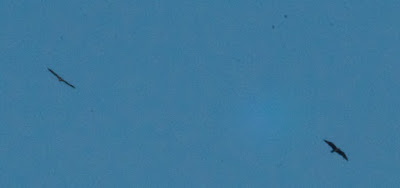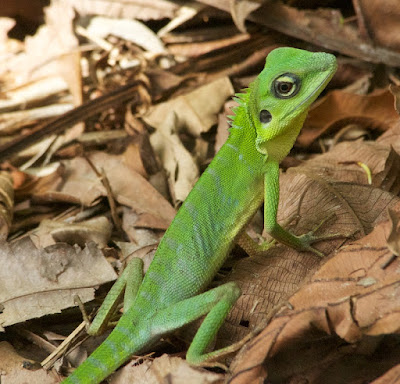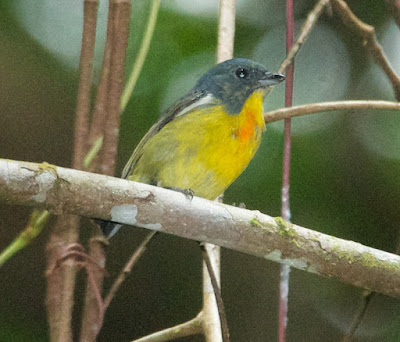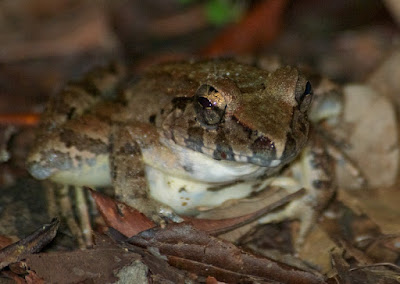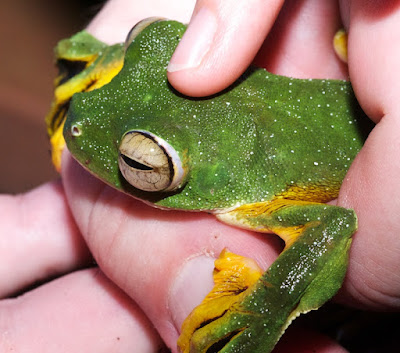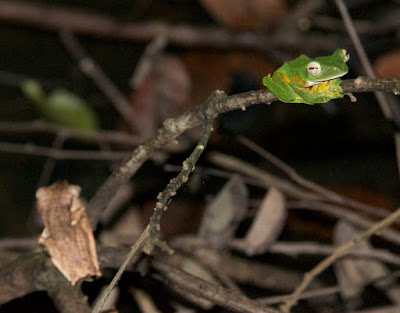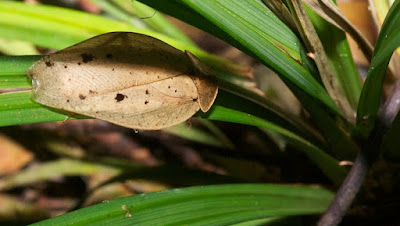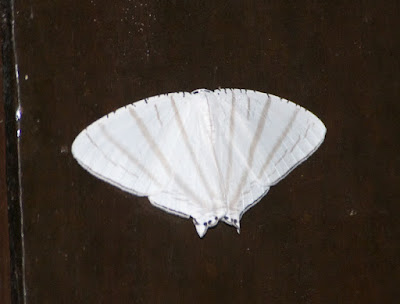If there is an ideal spot near Kuching for nature lovers to immerse themselves in tropical biodiversity, it is probably the famous frog pond at Kubah National Park. The chorus of lovelorn frogs that descend by night to the pond's edge has been declared the most beautiful sound in the natural world. The frog pond is also a great place to take the kids, so when the Malaysian Nature Society (Kuching Branch) decided to hold a family weekend there on February 22-23, 2014, I eagerly signed up with Ryan for a grandfather-grandson trip to the forest.


The main feature of the visit was to be a night walk, led by Hans Breuer (who is an expert at such things). I wanted to get there by late afternoon to try to photograph the resident Indaeschna grubaueri, a striking yellow-and-black darner dragonfly that haunts the area at about four o'clock in the afternoon. It did put in an appearance but, as usual, merely sped around the pond a few times before disappearing back into the forest. I was left to photograph this Cratilla metallica, which at least held still.
Plants make altogether more cooperative subjects.
Our weekend adventure began in earnest after dark, as we headed back up to the pond along the park road.
I stopped on the way to show Ryan a roadside colony of Nepenthes ampullaria, home to the tiny tadpoles of an endemic microhylid frog.
The bushes and low trees along the roadside gave us a number of delights even before we reached the pond. This gecko appears to be a member of the genus Cyrtodactylus, but I do not know which one.
A (presumed) male Wagler's Pit Viper (Tropidolaemus wagleri) sprawled over a thin limb over our heads (its stunning lime green colour is characteristic of juveniles and adult males). The Bornean population of this common venomous snake is sometimes regarded as an endemic species, the Bornean Keeled Pit Viper (T. subannulatus). It spends its life in the trees, hunting birds and small rodents. I'm not sure if it's true of this one, but arboreal pit vipers often have extremely potent and fast-acting venom - something they need, in order to ensure that, once bitten, their prey cannot get out of reach before it succumbs.
Some frogs turned up well before we reached the pond, including this Giant River Frog (Limnonectes leporinus).
Borneo boasts an amazing variety of phasmids - stick insects and their relatives - including some of the largest stick insects in the world. For some reason, one of the largest, spikiest and most fearsome-looking of them is known as the Jungle Nymph (Heteropteryx dilatata). Of course Jungle Nymphs are harmless, but a less nymph-like creature it would be hard to imagine. We came across a mating pair, either of a Jungle Nymph or one of its cousins, the much smaller male clinging determinedly to the female's back.
A few other phasmids, of varying degrees of spikiness, we found on their own.
I refuse to call anything in nature ugly, but even I have to admit there is a considerable difference between a grotesquely-spiked stick insect and an Oriental Dwarf Kingfisher (Ceyx erithaca). We found this little gem perched quietly on a twig just over our heads, obviously getting ready to settle down for the night before being interrupted by a gang of torch-weaving, flash-popping nature papparazzi (your correspondent included). I see these birds around the frog pond fairly frequently by day, but getting this close to one is another matter.
From the kingfisher it was only a few steps to the pond itself, and its remarkable collection of amphibians. Usually the pride of place is taken by the Harlequin Flying Frog (Rhacophorus pardalis), with its broadly-webbed pink toes.
This time, though, it was the night of a much more arresting species. I had long wanted to see the celebrated Wallace’s Flying Frog (Rhacophorus nigropalmatus), but had missed it on my previous visits. This time, though, Wallace's Flying Frogs appeared to be everywhere (well, we found four or five at least, which is pretty much 'everywhere' in my book).
Large (up to 10 cm), brightly-coloured and spectacularly-webbed, Wallace's (even if you ignore its ability to 'fly', or glide, or parachute) is surely one of the most magnificent of frogs. Wallace himself called it "One of the most curious and interesting reptiles [sic, by modern standards] which I met with in Borneo".
Of course it is the feet that have made it famous. Hans caught one so we could all get a closer look (note the remarkably 'pebbly' skin).
Set down on the boardwalk, it spread its front feet in the position it uses when it takes to the air (flaps of skin along its sides add to its gliding area). It isn't really much of a glider by comparison with, say, a flying squirrel or a dragon lizard, though it can sometimes manage a trip of 15 metres or so (and it isn't the only frog that can do this, though it may be the best at it). Anyway, we tried to get it to perform when we released it, but I'm afraid it only plopped disdainfully into the pond below.
Wallace's must be a lot commoner at Kubah than it appears. It apparently spends most of its time in the canopy; perhaps its breeding episodes are more seasonal or intermittent than the other frogs that haunt the pond, but I don't really know. I wonder if anyone does.
Wallace's Flying Frog is one of the Rhacophoridae, the dominant tree frogs of tropical Asia (quite unrelated to the Hylidae, the tree frogs of North America and Europe). The frog pond is rich in rhacophorids; here a Wallace's shares a perch with one of the others, a File-eared Tree Frog (Polypedates otilophus).
As faithful readers of this blog will know, File-eared Tree Frogs are pretty impressive creatures themselves - though in this writeup they will have to take second (or third) place to their green cousins.
More frogs lurked in the leaf litter beneath the boardwalk: another Giant River Frog (not a rhacophorid, but a member of the recently-split Dicroglossidae)....
... and the handsome and unusual Mahogany Frog (Hylarana luctuosa), a member of the "true" frog family Ranidae (only "true" because the original "frog" of Great Britain, first to bear that name, is a ranid).
It may not look it, but the more arboreal White-lipped Frog (Hylarana raniceps) is a ranid, too.
Of course there is more to the frog pond than frogs, or even vertebrates, as this large and handsome cockroach demonstrates (my use of the words "handsome" and "cockroach" in the same sentence displays my naturalist biases pretty clearly).
Hairy caterpillars like this are best admired and photographed, not touched (though whether this one has stinging, or urticating, hairs I did not know nor - recalling an incident when a particularly nasty one went down my collar - did I care to find out).
Spiders of all shapes and sizes are easy to pick out in the torchlight; they have particularly bright eyeshine (most annoying when you are hoping to turn up something more mammalian).
Here, a delicate and particularly long-legged fly suspends itself from the tip of one leaf...
...while a mottled slug glides over the surface of another. Is that rather scale-like pattern on its hindquarters meant to convince would-be slug-eaters that they are dealing, instead, with a snake (bearing in mind that among the major predators of forest slugs are snakes themselves)?
Finally, two creatures we found on our return, drawn in by the lights around our cabin (shared with my old friend and crack birder Yeo Siew Teck and his family): a strikingly-marked cricket...
...and a moth I can actually (I think) identify. It is Urapteroides astheniata, a member of the Uraniidae, the moth family that includes some brightly-coloured species that resemble swallowtail butterflies and are active by day. Urapteroides, though, a widespread insect ranging from India to tropical Australia, is definitely a creature of the night.
 Anyway, the day ended up being exciting for all (including Vincent, checking his photos, and myself, showing the students pictures, presumably of Bat Hawks, in our field guide). The whole thing got written up for the Borneo Post by my friend Asha Kaushal (this photo has been brazenly lifted from the Post web site) - helping to spread the word still further. So, thanks to the school, the students, the Malaysian Nature Society and everyone else involved for giving me a chance to send a message about nature to the people who will, one day, hold its fate in their hands - and, besides, to have fun in the process!
Anyway, the day ended up being exciting for all (including Vincent, checking his photos, and myself, showing the students pictures, presumably of Bat Hawks, in our field guide). The whole thing got written up for the Borneo Post by my friend Asha Kaushal (this photo has been brazenly lifted from the Post web site) - helping to spread the word still further. So, thanks to the school, the students, the Malaysian Nature Society and everyone else involved for giving me a chance to send a message about nature to the people who will, one day, hold its fate in their hands - and, besides, to have fun in the process!



